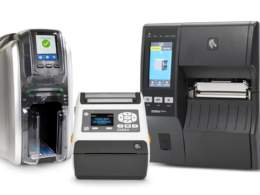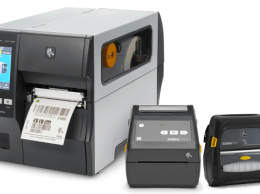4 Solutions for Product Printing and Coding
When it comes to adding variable information such as batch numbers and best before dates directly onto your products, some manufacturers have been using the same methods for years. Unfortunately, those methods are outdated and often inefficient in terms of financial cost. We live in a manufacturing world where the pace is ever quickening, and regulations are ever-tightening. Speed of application, traceability and accuracy of coding has become a business imperative. Companies unwilling to automate or adapt their current processes are missing an opportunity to increase efficiencies and eliminate waste from their operations.
For example, it’s not uncommon for businesses to produce best before labels in a separate print room and apply these labels by hand, or even use handheld coding guns. These both present several risks and inefficiencies. There’s no failsafe for human operators applying incorrect labels, hamstringing your traceability efforts and damaging customer satisfaction. It could also be deemed an inefficient use of your employees’ time, applying labels by hand, as they could be better utilised adding value elsewhere within your organisation. Operators do not always apply labels uniformly in terms of positioning onto the product, and then there’s the physical space that’s wasted when you have a separate print room. Space that could be utilised for something else – such as a meeting room or breakout area.
Thankfully there are alternatives.
Alternatives that bring increased speed, simplicity and more savings to your production environment.
Technologies

Thermal transfer overprinting
Thermal transfer overprinters can be used at high speeds to produce high-quality codes on flexible films and labels. TTO printing is a preferred technology for batch coding processed and convenience food, with printers integrated into packaging and processing equipment including tray sealers, flow wrappers, and baggers.
In a TTO solution, a code is transferred directly onto a product packaging or label, using heat applied to an ink ribbon in a specified target area, as such the print head must come into full contact with the print area to produce a code.

Continuous inkjet printing
Quite simply, continuous inkjet printing technology is one of the most frequently chosen coding solutions. It is fast, durable, designed to be easy to operate, flexible to install and, best of all, is extremely versatile: it can print on virtually any surface, from thin plastic film to thick ridged metal.
Continuous inkjet printers are used in a variety of different industries, including food, beverage, and industrial and manufacturing sectors. They are designed to withstand harsh conditions and are perfect for printing small text onto your product.

Thermal inkjet printing
Thermal Inkjet printers are non-contact ink coding machines that can achieve high-resolution printing, at very fast speeds. These are ideal for the mass coding of drug and medical devices with increasingly sophisticated codes and messages.
TIJ printers can print lasting, rub and scratch resistant codes, logos and graphics on paper, card, plastic, metal and many other materials. Rapid dry times and good adhesion deliver optimum performance on fast-paced production lines.

Laser coding
For some applications, a non-ink-based batch coder may present the best solution. For example, in the beverage sector, printing batch codes on the bottom of beer cans, wine bottles, and water bottles will require a system capable of printing on foil seals, PET, and glass, such as a scribing laser.
The ideal solution when you need optimum print code quality from a compact machine, laser printers integrate effectively into your existing production line, even when you have limited space. Not only capable of delivering both human-readable and 2D datamatrix coding, these provide legally compliant solutions to serialisation directives or other traceability demands. Needing no inks or solvents, they minimise waste, and automatic temperature control cooling means the printer saves energy wherever possible. They are also by far the fastest type of coder, which means more throughput and faster production.
Options for handling batch code information
Another important consideration when choosing a batch coding machine is how you would like to handle your data. There are various options available from manual data entry, to full coding automation.
Manual data control
At entry-level, data can be entered directly onto a batch coding machine for printing onto a product. In such a scenario, an operative would be employed to enter all data onto a label design or code template. The machine would then print the code onto the product. Such a system can be susceptible to coding errors if an operative makes a mistake during data entry, which can necessitate product recalls.
Semi-automated control
Another option for manufacturers is semi-automated data control, where a batch coder can automatically populate a label or code template based on certain information. In such a scenario, an operative would be required to enter data from defined categories, for example, date, product code, line number, etc., into a piece of software that would then translate the data into final code for printing. Domino’s QuickStep user interface is provided with all PrintDATA’s batch coding machines, enabling operatives to design labels and code structure, and automatically populate designs based on manually entered information.

Fully automated data control
A more advanced solution for manufacturers comes in the form of batch coding software that can integrate into an existing supply system to create batch numbers based on product data and automatically populate the label software. Domino’s QuickDesign coding automation and label design software enables all Domino printers to integrate into MES and ERP systems, to accurately collect and curate data and automatically switch messages. A coding automation system eliminates the need for human touch, resulting in fewer errors, less downtime, and greater operator capacity to carry out tasks elsewhere on the factory floor.
How much does it cost?
The cost of a batch coding system will vary greatly depending on an individual factory set-up, the type of technology required, the number of machines, and the number of products that need coding. Ultimately there is a balance to be struck between the number of codes needed, the initial set up cost, and the cost of running a machine over time. There are a variety of specific products in each product range, meaning more chance of finding one to suit your budget.
Ask the experts
PrintDATA provides a large range of batch coding machines for a variety of uses and sectors. You can view our full range here.
If you are looking for a batch coding machine, we have a solution for you. With options available for TTO, CIJ, TIJ, and laser coding, you are sure to find your ideal solution within our range. All of our printers are available with coding automation software, allowing you to integrate your batch coding machine into existing systems, and fully automate the batch coding process.
Please get in touch to discuss your individual requirements with one of our experts, who will guide you through the selection process, to ensure that you find the perfect solution to your batch coding requirements.







